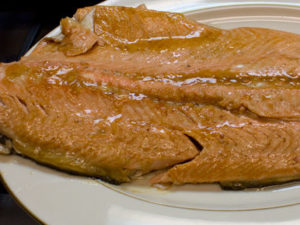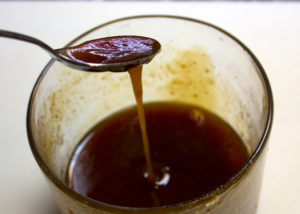 I was making all the food for a women’s tea on Saturday, and we were having the company for Sunday dinner that we should have had the week before, only we were snowed in, so I needed something simple. Fortunately, that was what I had already planned anyway. No multi-step recipes, no fancy dessert. I wanted to make something we’d had before, a salmon dish with some kind of sauce made with cider and cream. But when I went online to look for it I couldn’t find anything that sounded right. At some point I re-stumbled upon the recipe which turned out to be in Molly Wizenberg’s
I was making all the food for a women’s tea on Saturday, and we were having the company for Sunday dinner that we should have had the week before, only we were snowed in, so I needed something simple. Fortunately, that was what I had already planned anyway. No multi-step recipes, no fancy dessert. I wanted to make something we’d had before, a salmon dish with some kind of sauce made with cider and cream. But when I went online to look for it I couldn’t find anything that sounded right. At some point I re-stumbled upon the recipe which turned out to be in Molly Wizenberg’s
wonderful book, A Homemade Life. There are a couple of per-oblems with her ideas, though. For one thing, as the title might imply, she calls for cider. But cider (even the ersatz pasteurized stuff) is only available in the fall. After that, you’re stuck with the apple juice in the juice aisle, and it’s expensive, and I don’t think it has much flavor. And, as in many recipes that all for cider, you’re supposed to reduce it down. So I use one of two alternatives to the cider.
 One is cider syrup. Don’t buy this stuff, for heaven’s sake! It’s ridiculously expensive. You can make your own. Just be sure that during cider season you buy more than you’ll drink up. Put the leftover cider into a stainless-steel saucepan and boil it down until it’s syrupy. Keep an eye on it for the last little bit, and it’s easy to overdo it. I got this idea originally from the wonderful cookbook Beat That by Ann Hodgman. I reference her a lot. Anyway, she says, “Now boil it and boil it and boil it, for way longer than you could have believed was possible.” You’ll get about a pint of cider syrup out of a gallon of cider, which means you get one-eighth of what you started out with.
One is cider syrup. Don’t buy this stuff, for heaven’s sake! It’s ridiculously expensive. You can make your own. Just be sure that during cider season you buy more than you’ll drink up. Put the leftover cider into a stainless-steel saucepan and boil it down until it’s syrupy. Keep an eye on it for the last little bit, and it’s easy to overdo it. I got this idea originally from the wonderful cookbook Beat That by Ann Hodgman. I reference her a lot. Anyway, she says, “Now boil it and boil it and boil it, for way longer than you could have believed was possible.” You’ll get about a pint of cider syrup out of a gallon of cider, which means you get one-eighth of what you started out with.
Your other alternative is frozen apple juice concentrate. If you’ll notice on those glass bottles in the juice aisle, you’re usually buying “juice from concentrate” anyway. So, follow me here: First the juice is boiled down to make a concentrate. Then it’s reconstituted and sold in a bottle to you, and you’re paying for them to add water, and then for this recipe you boil it right back down again. So why not just start with the concentrate to begin with? I try to always have a can or two or frozen apple and orange concentrates on hand. They’re much cheaper than the reconstituted juices.
And then she wants you to cook the salmon on the stovetop, but I don’t like doing that, especially with such a big piece. (Mine was almost three pounds, and there were only six of us for dinner, and we pretty much demolished it–there was a tiny little piece left for Monday lunch.) Molly’s recipe says to use 6-ounce fillets, but I don’t want to do that. I like the look of a big old piece of salmon filling up the platter. (You can see in the picture above that I didn’t quite get it onto said platter without breaking it up a little. As I’ve said before, the pictures on this blog are definitely not posed or styled.)
I will also say that I don’t really like wild-caught salmon. Every year Costco has a big sale of the Copper River salmon that’s only available during the season, so I’ve dutifully bought it in the past, thinking that ‘Oh, great–this is the good stuff and worth paying extra for’ and then not really liking it much. So, although this probably brands me as a terrible person, I just buy the el cheapo farmed salmon from the grocery store, and if it’s on sale, so much the better. The farmed stuff has more fat, which makes it buttery and smooth. (And it also has color added, I know–which makes it pretty!) I love it. And it needs to have the skin on, which protects the flesh and adds flavor. So don’t take it off, as some misguided recipes tell you to do. You can remove it as you cut up and serve the fish from the platter.
One other thing: It’s totally worth it to brine the salmon for 15 minutes before you cook it. The standard brine for meat is a quarter of a cup of salt to a quart of water. (This is regular table salt. Let’s not get into the weeds of salt types here, except to say that kosher salt has bigger crystals and so takes up more space, so you usually need twice as much as regular table salt. I refuse to agonize over salt. Robert Wolke, a former chemistry professor turned food writer and the author of What Einstein told His Cook and the wonderful “Food 101” column that used to appear in the Washington Post, made some enemies in the snooty food community years ago when he wrote a column about how silly it was to pay big bucks for sodium chloride. I’d love to track down that article.) Anyway, because fish is much more flimsy (that’s the technical word) than meat, I find that the standard brine makes it too salty. So I just use 2 tablespoons (table) salt per quart of water and brine the salmon right in the baking dish I’m going to use to cook it in. Put it skin side up, so that the flesh is submerged. When the 15 minutes are up, carefully pour the brine out in the sink–you’ll have to use a spatula or something to keep the salmon in the dish–and pat the fish dry with paper towels. Flip it over so that now it’s skin side down and proceed with your recipe. The brining step will help keep the salmon moist and will at least minimize the horrible white albumen protein that comes out on the surface if you overcook it by even 30 seconds.